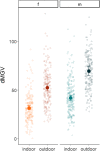The potential for cleaner fish-driven evolution in the salmon louse Lepeophtheirus salmonis: Genetic or environmental control of pigmentation?
- PMID: 34188857
- PMCID: PMC8216962
- DOI: 10.1002/ece3.7618
The potential for cleaner fish-driven evolution in the salmon louse Lepeophtheirus salmonis: Genetic or environmental control of pigmentation?
Abstract
The parasitic salmon louse represents one of the biggest challenges to environmentally sustainable salmonid aquaculture across the globe. This species also displays a high evolutionary potential, as demonstrated by its rapid development of resistance to delousing chemicals. In response, farms now use a range of non-chemical delousing methods, including cleaner fish that eat lice from salmon. Anecdotal reports suggest that in regions where cleaner fish are extensively used on farms, lice have begun to appear less pigmented and therefore putatively less visible to cleaner fish. However, it remains an open question whether these observations reflect a plastic (environmental) or adaptive (genetic) response. To investigate this, we developed a pigment scoring system and conducted complimentary experiments which collectively demonstrate that, a) louse pigmentation is strongly influenced by environmental conditions, most likely light, and b) the presence of modest but significant differences in pigmentation between two strains of lice reared under identical conditions. Based on these data, we conclude that pigmentation in the salmon louse is strongly influenced by environmental conditions, yet there are also indications of underlying genetic control. Therefore, lice could display both plastic and adaptive responses to extensive cleaner fish usage where visual appearance is likely to influence survival of lice.
Keywords: Lepeophtheirus salmonis; aquaculture; cleaner fish; environmental; genetic; pigmentation; plasticity.
© 2021 The Authors. Ecology and Evolution published by John Wiley & Sons Ltd.
Conflict of interest statement
The authors declare that they have no conflict of interest.
Figures






Similar articles
-
Modelling sea lice control by lumpfish on Atlantic salmon farms: interactions with mate limitation, temperature and treatment rules.Dis Aquat Organ. 2019 Feb 21;133(1):69-82. doi: 10.3354/dao03329. Dis Aquat Organ. 2019. PMID: 31089004
-
How are the salmon lice (Lepeophtheirus salmonis Krøyer, 1837) in Atlantic salmon farming affected by different control efforts: A case study of an intensive production area with coordinated production cycles and changing delousing practices in 2013-2018.J Fish Dis. 2019 Nov;42(11):1573-1586. doi: 10.1111/jfd.13080. Epub 2019 Sep 10. J Fish Dis. 2019. PMID: 31506962
-
Time-to-response toxicity analysis as a method for drug susceptibility assessment in salmon lice.Aquaculture. 2016 Nov 1;464:570-575. doi: 10.1016/j.aquaculture.2016.08.007. Aquaculture. 2016. PMID: 27812230 Free PMC article.
-
How sea lice from salmon farms may cause wild salmonid declines in Europe and North America and be a threat to fishes elsewhere.Proc Biol Sci. 2009 Oct 7;276(1672):3385-94. doi: 10.1098/rspb.2009.0771. Epub 2009 Jul 8. Proc Biol Sci. 2009. PMID: 19586950 Free PMC article. Review.
-
Analysis and management of resistance to chemotherapeutants in salmon lice, Lepeophtheirus salmonis (Copepoda: Caligidae).Pest Manag Sci. 2002 Jun;58(6):528-36. doi: 10.1002/ps.482. Pest Manag Sci. 2002. PMID: 12138619 Review.
Cited by
-
Evolutionary predictions for a parasite metapopulation: Modelling salmon louse resistance to pest controls in aquaculture.Evol Appl. 2023 Nov 23;16(12):1982-1998. doi: 10.1111/eva.13618. eCollection 2023 Dec. Evol Appl. 2023. PMID: 38143899 Free PMC article.
-
Control of parasitic diseases in aquaculture.Parasitology. 2022 Dec;149(14):1985-1997. doi: 10.1017/S0031182022001093. Epub 2022 Aug 11. Parasitology. 2022. PMID: 35950444 Free PMC article. Review.
-
Aquaculture-driven evolution of the salmon louse mtDNA genome.Evol Appl. 2023 Jun 28;16(7):1328-1344. doi: 10.1111/eva.13572. eCollection 2023 Jul. Evol Appl. 2023. PMID: 37492153 Free PMC article.
References
-
- Abolofia, J. , Wilen, J. E. , & Asche, F. (2017). The cost of lice: Quantifying the impacts of parasitic sea lice on farmed salmon. Marine Resource Economics, 32(3), 329–349. 10.1086/691981 - DOI
-
- Besnier, F. , Kent, M. , Skern‐Mauritzen, R. , Lien, S. , Malde, K. , Edvardsen, R. B. , Taylor, S. , Ljungfeldt, L. E. R. , Nilsen, F. , & Glover, K. A. (2014). Human‐induced evolution caught in action: SNP‐array reveals rapid amphi‐atlantic spread of pesticide resistance in the salmon ecotoparasite Lepeophtheirus salmonis . BMC Genomics, 15(1), 15–937. 10.1186/1471-2164-15-937 - DOI - PMC - PubMed
LinkOut - more resources
Full Text Sources

